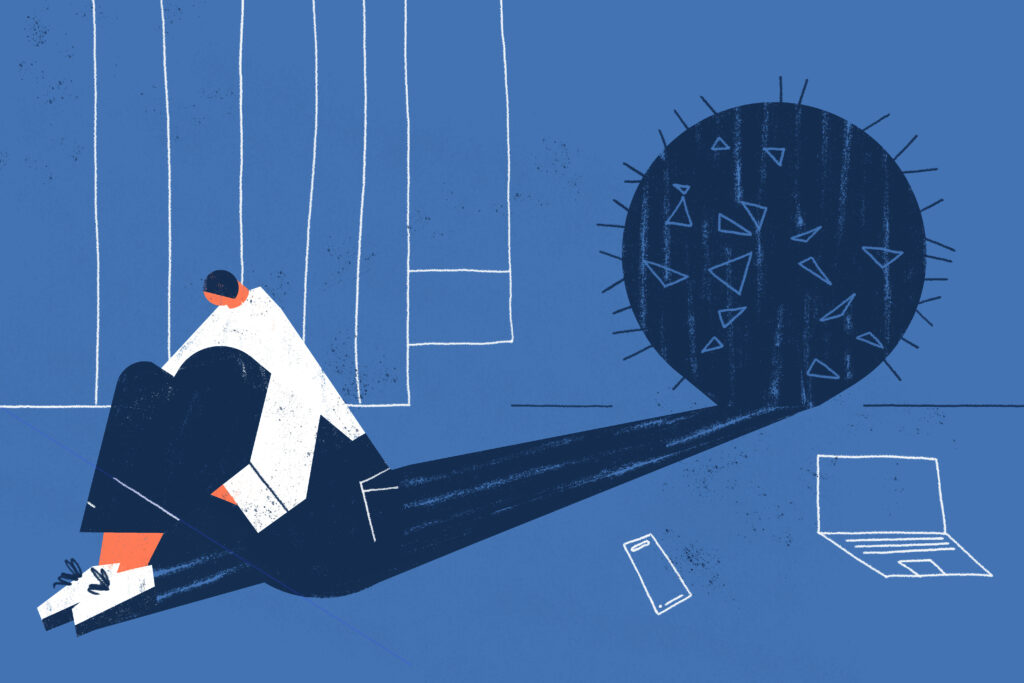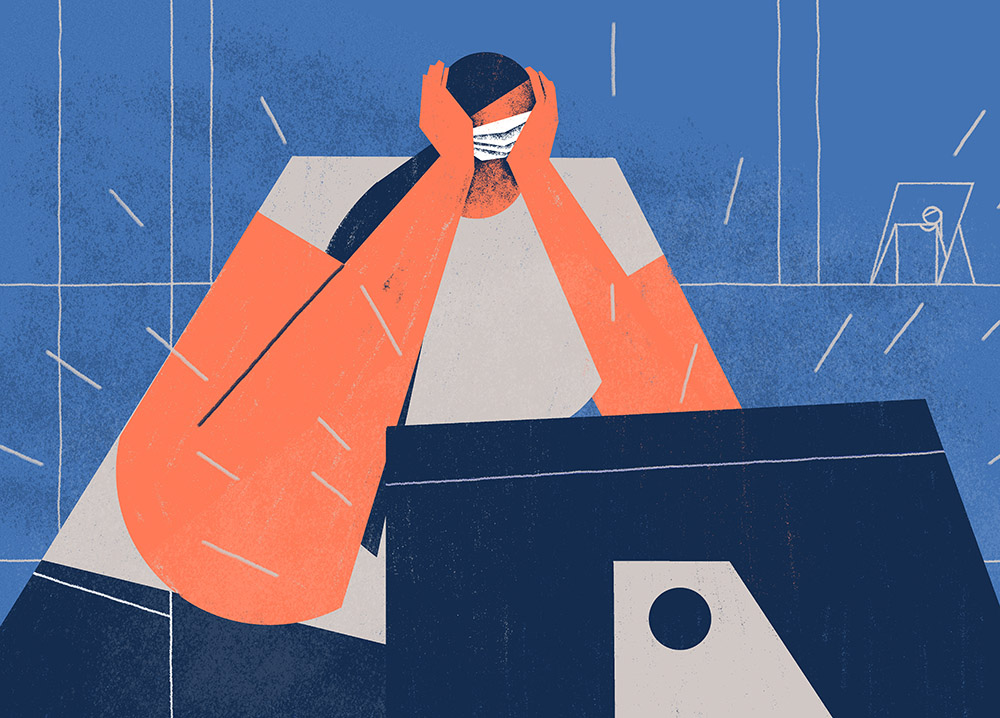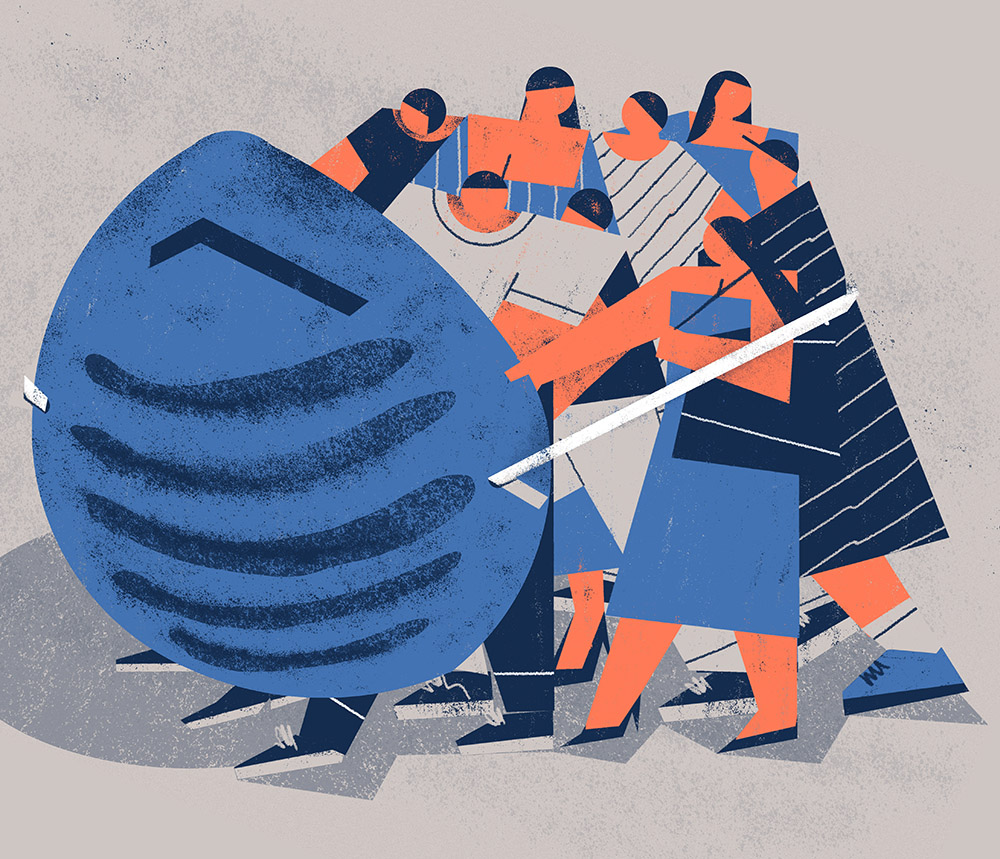Breadcrumb
Burned Out
By Debra Venzke
Published on December 7, 2021
The stresses of the COVID-19 pandemic have taken a toll on the mental health of the public health workforce. Local public health leaders share their experiences and strategies for fostering healing.

The COVID-19 pandemic has been detrimental to many people’s mental health, with the stresses on workers in health care, education, and other essential services frequently highlighted. Less often, however, has attention been focused on the mental health needs of the public health workforce that has been in the trenches 24/7 since the beginning of the pandemic.
Public health is the “invisible frontline,” says Lina Tucker Reinders, executive director of the Iowa Public Health Association. She compares the nonstop demands of the pandemic to a blizzard. “There’s overtime for the road crew, long hours, and it’s stressful—that’s been the pandemic for local public health for more than 19 months,” she says. “They’ve had no time off, they haven’t seen their families and friends.”
On top of their other duties, public health workers have to stay up to date with changing guidance about the virus and regularly answer questions from the media and the public, Tucker Reinders says. Many staffers also have had to deal with threats and verbal abuse.
“They’re getting calls, sometimes from people with basic questions, other times those calls are angry and vitriolic,” she says. And there’s never a break; they might get peppered with questions or remarks from neighbors while out grocery shopping. “Everyone knows you work in public health in a small community,” she says.
Danielle Pettit-Majewski (10MPH), director of Johnson County Public Health in Iowa City, Iowa, is bluntly honest about the effect of pandemic stress on the workforce. “Public health workers are burned out,” she says. “I know I myself struggled with PTSD, anxiety, and memory loss during my response to the pandemic. I’ve heard from other colleagues that they have considered leaving public health or retiring early. It’s been absolutely exhausting and we’ve never been given the kudos our colleagues in health care have, despite all of our efforts.”
Addressing Workforce Needs
Pettit-Majewski is not alone in her experience. A report published in the CDC’s Morbidity and Mortality Weekly Report (MMWR) in July 2021 revealed that among 26,174 state, tribal, local, and territorial public health workers surveyed in March-April 2021, 53% reported symptoms of at least one mental health condition in the past two weeks. Respondents reported depression (32%), anxiety (30.3%), PTSD (36.8%), or suicidal ideation (8.4%). Symptoms were more prevalent among those who were unable to take time off or worked 41 or more hours per week.

The survey found that prevalences of symptoms of depression and anxiety among public health workers were similar to those in previous reports among health care workers; however, prevalence of PTSD symptoms among public health workers was 10% to 20% higher than that previously reported among health care workers, frontline personnel, and the general public.
“When we saw that report and from what we were hearing anecdotally, we had to pick up the mantle and address this,” says Tucker Reinders.
The survey “really started to shed light on just how important this was,” adds Laurie Walkner, co-coordinator of the Midwestern Public Health Training Center (MPHTC) and interim director of the Institute for Public Health Practice at the University of Iowa College of Public Health. “No one really delved into the needs of the public health workforce until the survey results were published in MMWR in summer.”
In response, the IPHA and MPHTC organized a workshop addressing the topic. Held on Aug. 24, 2021, the workshop was geared toward leaders of public health departments with the purpose of normalizing and validating conversations around employee burnout and mental health, as well as developing skills and tools to foster healing. The in-person workshop was held in Des Moines with attendance capped at about 24 participants to maintain social distancing.
“We had some good conversations and presentations on burnout recognition and acknowledging and talking about how to have these conversations with staff members,” says Walkner. “In the afternoon session, we could really focus on what was going on in the health departments. What were people doing? How did they start these conversations? What are ways that we can support each other in this?”
Fatigue and Finding Balance
As part of the workshop, both Pettit-Majewski and Brad Brake, director of Harrison County Home & Public Health in western Iowa, shared insights about their own personal and professional experiences.
“As someone who lives with mental illness, pandemic or no pandemic, I have had to be extremely proactive and flexible with my own mental health,” says Brake. “This has entailed increasing to weekly therapy appointments and more frequent medication checkups with my physician. I’ve had to lean heavily on my colleagues and staff for support these last few years in order to keep focus on making sure we are doing everything possible to slow COVID transmission in the community.
As for what I am seeing from employees and colleagues–fatigue. Fatigue of the pandemic. Fatigue from lack of supports. Fatigue of fighting misinformation.
Brad Brake, director of Harrison County Home & Public Health
“As for what I am seeing from employees and colleagues—fatigue,” he continues. “Fatigue of the pandemic. Fatigue from lack of supports. Fatigue from having to carry on with the ‘typical’ duties in tandem with the pandemic response. Fatigue of fighting misinformation and all of the local vitriol that can come with that. It’s more than understandable that we are seeing a mass exodus of public health workers either through retirement or through other opportunities. This fatigue is leading to depression, anxiety, PTSD, and apathy. We, as a state, need to be more proactive in how we are taking care of the workforce.”
Tucker Reinders and Walkner say they have received positive feedback and evaluations of the workshop. The event “was so beneficial that we’re bringing in some of the same speakers to present to our staff during a retreat,” adds Pettit-Majewski. “I’ve also had lots of conversations with my staff about finding balance and ensuring they take time to recover when they’re not at work.”
Brake is also supporting his staff in as many ways as possible. “You name it—I’m trying it,” he says, ticking off approaches such as relaxing the office dress code, increasing flexibility with weekly work schedules, adding staff to cover additional hours as needed, and holding an all-staff “mental health retreat” day to focus on burnout prevention and self-care practices. He also has staff complete burnout assessments and talk to him if their score hits a certain threshold.
Brake stresses the importance of taking vacation and mental health time. “The pandemic will be here. Take the time you need to recharge.”
Threats to Public Health
The MMWR report provided a much-needed sliver of insight into the challenges and exhaustion facing the public health workforce as the pandemic drags on. Making the situation even more discouraging is the hostile reaction to public health measures by segments of the public. In the MMWR survey, respondents reported receiving job-related threats because of work (11.8%), and feeling bullied, threatened, or harassed because of work (23.4%).

In October 2021, the National Association of County and City Health Officials (NACCHO) wrote to the U.S. Attorney General strongly urging the Justice Department to include public health department officials and staff in a federal effort to protect school-related personnel from the increased risk in harassment, intimidation, and threats of violence.
The letter states: “While the pandemic has brought greater appreciation by many to the importance of public health and the people who work in the field, too many health department leaders and their staff have experienced threats to their jobs, their safety, and their family members. These threats have come from community members, organized (and armed) anti-government militias, and politicians. … These threats have taken a toll: at least 300 public health department leaders have left their posts since the pandemic began, impacting 20% of Americans.”
An October 2021 New York Times article dug into the issues posing a crisis to the U.S. public health system, including loss of staff, an increase in laws limiting state and local health powers, lack of community support, and concerns about funding levels. The authors concluded that their “review of hundreds of health departments in all 50 states indicates that local public health across the country is less equipped to confront a pandemic now than it was at the beginning of 2020.”
Tucker Reinders echoes the concerns about budget and staffing, citing a report by the de Beaumont Foundation and Public Health National Center for Innovation. The report estimates that state and local public health departments need nearly 80,000 more full-time equivalent positions just to meet basic health requirements. She advocates for an increase in unrestricted resources dedicated to public health departments to hire staff and provide relief to overworked staff.
“We need resources for people to access mental health care,” she adds, noting that she’d also like to replicate the mental health workshop and offer it around the state.
Remaining Resilient
Even in the current challenging climate, most public health workers remain committed to their mission.
“Despite the fact that we’re in year two of a pandemic, now is an incredibly exciting time to be in public health,” says Pettit-Majewski.
While public health has long been “discussing among ourselves how social determinants of health and health inequities lead to adverse health outcomes, the pandemic has given everyone in the world a front row seat to how that looks in real life,” she says. “Now is a time to use our advocacy skills and plan for how we can implement public health practices that will close those gaps and make our communities more resilient in the next disaster.”
This story originally appeared in the fall 2021 issue of InSight.